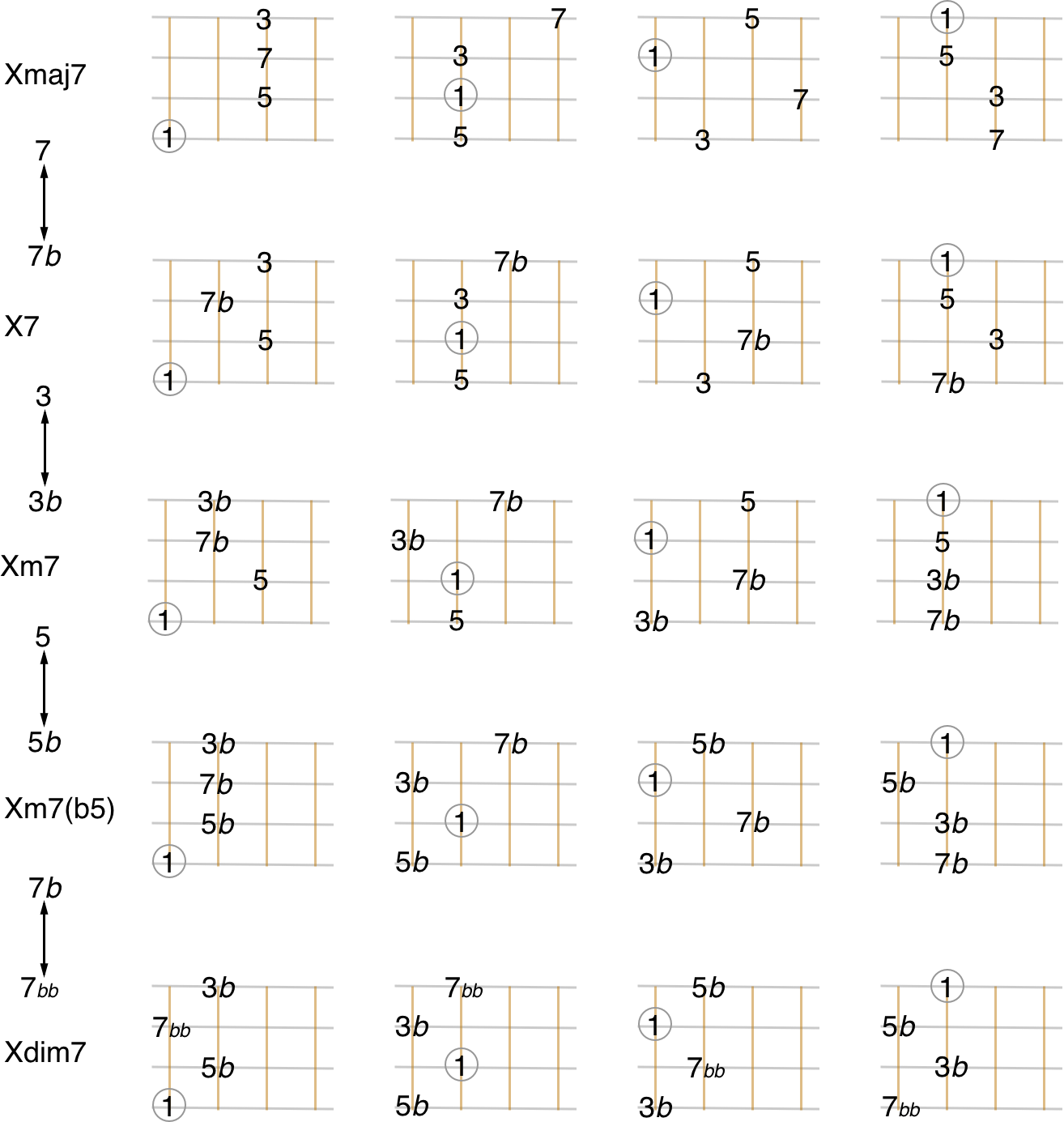Jazz Chords for Baritone Ukulele — Now part of the full book!
I’ve been working on learning jazz chords, and how to derive them myself, rather than try to memorize lots of dots on frets diagrams. I’m using the baritone ukelele for this because it only has four strings, which line up nicely with the four notes in most jazz chords. This simplifies things somewhat.
So, I started with 7th chords and made an amazing discovery! The diminshed 7ths are at the root of all 7th chords! Here’s the big picture:

(Note on diagrams — these are the four strings and the fingerings, but instead of dots, the position in chord is written so you can see how it’s constructed. These fret all the strings, so the fingerings can be moved. The chord being played is based on whatever note is under the circled 1.)
Backing up, the idea is to come up with moveable chord fingerings with the root on any one of the four strings. So for each chord, such as minor 7th, there are four different fingerings, allowing it to be played multiple ways at multiple positions on the fret board.
I had been working from regular 7th fingerings, and then started to add others, and was moving towards the diminshed 7ths when… They were all the same fingerings. No matter which string was the root, the fingering of a diminshed 7th chord was the same. Just the role played by each note was different.
How cool is that!
Why is that? A diminshed 7th is made up 1 3b 5b 7bb. All the intervals are minor thirds. Even 7bb – 1 is a minor third, so it just keeps going and going.
The various inversions for the different root strings are:
- 1 5b 7bb 3b
- 5b 1 3b 7bb
- 3b 7bb 1 5b
- 7bb 3b 5b 1
Note how well those inversions line up with the 4th 3rd 4th tuning of the baritone uke (and four high strings of a guitar)(and regular uke as well). 1 – 5b, and 7bb – 3b are augmented fourths (two minor thirds) and bridge neatly across the 4th tuned strings. But so are 5b – 1 and 3b – 7bb, because the augmented fourth is the only symmetric interval.
Those pairs are then joined by, say, 5b – 7bb, a minor third, which falls nicely across the center third tuning. As do all the other inversions.
Anyway, starting with these inversions you can make single fret changes to gradually create any of the 7th chords. That is, understanding these inversions, and then removing the required flats lets you derive, in your head, any of these jazzy 7th chords.
Just pick a root, say you want a G7 around the middle of the keyboard. So take the 4th string 5th fret, a G, make the diminished 7th chord, and then move each of the other fingers up a fret, 5b -> 5, 7bb -> 7b, 3b -> 3b, and you’ve got G7 on the fifth fret!
Want to slide from there into a Cmaj7? Well C is on the third string 5th fret. Leave that finger be, take all the others up a fret, and then take the 7b up one more and you’ve got Cmaj7.
ii – V – I is a classic jazz progression. To add the minor 7th to the two chords above, I like the D on third string 7th fret. Start with the diminished 7th with the root on there. Move the 7bb and 5b each up one, leaving the 3b alone.
Now you can play Dm7 – G7 – Cmaj7, classic ii V I. Isn’t it sweet?
Jazz Chords for Baritone Ukulele — Now part of the full book!


